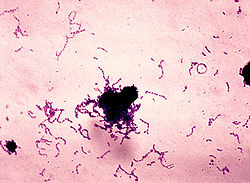Streptococcus mutans
Streptococcus mutans is a gram-positive bacteria that lives in the mouth, specifically on teeth. This bacteria grows optimally in the range of 18-40 degrees Celsius. First described by James Killian Clarke in 1924,[1] the bacteria is the most common cause of tooth decay and cavities.[2]
| Streptococcus mutans | |
|---|---|

| |
| Stain of S. mutans in thioglycollate broth culture. | |
| Scientific classification | |
| Kingdom: | |
| Phylum: | |
| Class: | |
| Order: | |
| Family: | |
| Genus: | |
| Species: | S. mutans
|
| Binomial name | |
| Streptococcus mutans Clarke 1924
| |
Role in tooth decay
Along with Neisseria spp., various species of streptococci, including ``S. mutans``, and some fungi, form a biofilm known as dental plaque.[3] S. mutans plays a major role in tooth decay, metabolizing sucrose into lactic acid.[2]
References
- ↑ "The Biology of Streptococcus mutans". National Library Of Medicine.
- ↑ 2.0 2.1 Loesche WJ (1996). "Ch. 99: Microbiology of Dental Decay and Periodontal Disease". In Baron S (ed.). Baron's Medical Microbiology (4th ed.). University of Texas Medical Branch. ISBN 978-0-9631172-1-2. PMID 21413316.
- ↑ Vinogradov AM, Winston M, Rupp CJ, Stoodley P (2004). "Rheology of biofilms formed from the dental plaque pathogen Streptococcus mutans". Biofilms. 1: 49–56. doi:10.1017/S1479050503001078.